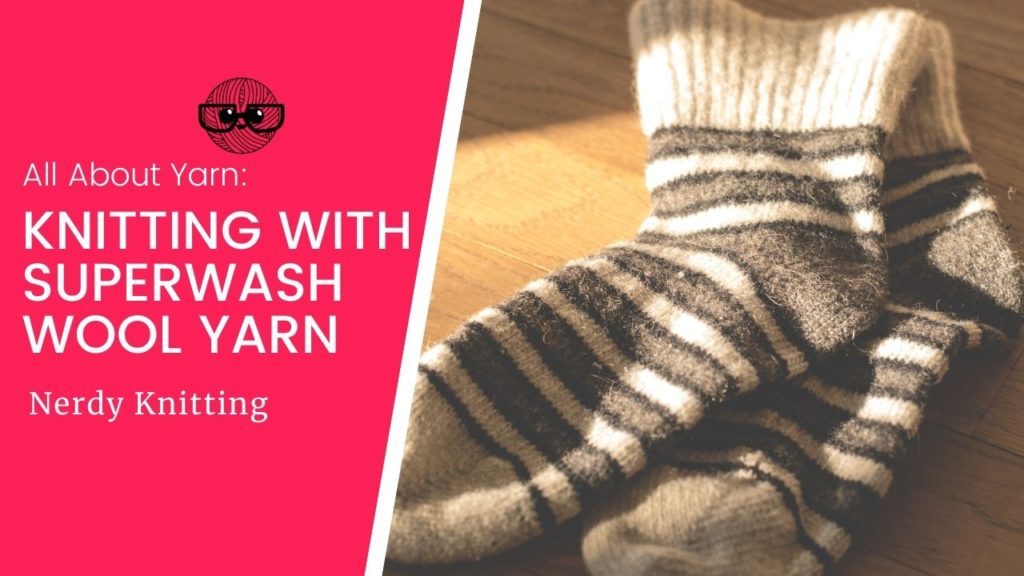Superwash wool yarn is a unique yarn that has been treated to make the wool fibers machine-washable. Wool fibers are naturally covered in scales (just like human hair) but these scales have a tendency to stick together or felt. In the process to make them machine-washable, the wool fibers are coated or removed so the scales can’t stick together – and this means the resulting yarn that is spun from these fibers can be machine washed without felting.
While superwash wool is certainly easier to care for, there are some things you’ll want to know about this type of wool before you start knitting. In this article we’ll look at all the facts about knitting superwash wool:
- How Superwash Wool is Made
- Properties of Superwash Wool
- Knitting with Superwash Wool Yarn
- Caring for Finished Projects
- Buying Superwash Wool Yarns
- More Questions about Superwash Wool
Let’s take a closer look at each of these areas. Then you’ll know exactly when to choose superwash wool yarn for your next knitting project.
Some links below are affiliate links. If you click through and make a purchase I may receive a small commission at no extra cost to you. See the disclosure policy for more information.
How Superwash Wool is Made
Superwash wool uses a chemical process to remove the scales from the wool (the original method burned off the scales using a chlorination process). Instead of removing the scales, newer methods coat the wool fibers in a plastic or polymer resin that glues the scales down. When these scales are removed or glued down, the resulting yarns are smooth and the wool fibers won’t felt together (like natural wool has a tendency to do).
The addition of heat, moisture, and agitation to natural, untreated wool is what causes the scales on those fibers to stick together, resulting in a felted fabric. Because those scales are coated or removed in the superwash wool manufacturing process, the risk of felting is greatly reduced (though not completely eliminated).
With time and heat (especially hot water or hot settings on a dryer), the plastic or polymer resin that coats the fibers in superwash wool can eventually wear away. When this happens, and enough scales are uncovered, the wool will eventually felt.
But, as long as you are aware that this can eventually happen, and understand some of the characteristics of superwash wool, you can still confidently use superwash wools for knitting.
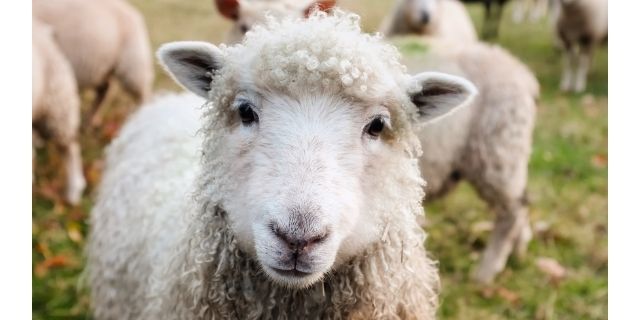
Properties of Superwash Wool
Because superwash wool has been treated to make a smooth, even textured yarn, it loses some of the advantages that it had as an untreated natural fiber. But it does have one advantage – superwash wool won’t felt when it gets washed.
Advantages of Superwash Wool

The clearest advantage to superwash wool is that it is machine-washable – one of the things that often make people choose yarns other than regular wool (which usually is hand-wash only). Other reasons to choose superwash wool include:
- non-felting
- smooth
- soft
- good drape
- takes dye well
Because superwash wool is softer and smoother than non-superwash wools, the fibers don’t stick together in the same way and this is why you’ll see more drape in a hand-knit garment that’s made with superwash wool. The stitches can more freely move and slide instead of stick together (this is also why the tendency to stretch and sag occurs – as you’ll see in the next section).
Another advantage of superwash wools is how receptive they are to dye. If you’ve ever seen a display of superwash wool in a small yarn shop you may have noticed the bright, beautiful, and bold colors. Superwash yarns are easy to dye in a wide-range of colors.
Even novice dyers can try their hand at hand-dyeing yarn with superwash wool. Heat is usually involved (which is one of those things that makes felting easily occur) but the risk of felting is very low with a superwash wool so it’s a great base yarn to try out some hand-dyeing before attempting to dye natural wool yarns.
Disadvantages of Superwash Wool
The major disadvantage with superwash wool is that it has a tendency to stretch out, grow, and sag. Wool naturally holds its shape because the untreated fibers tend to stick together. But when those fibers are treated or coated so they can’t stick together, there’s nothing that’s helping the yarn (and your project) hold its shape.
Along with this tendency to sag and grow there are a few more disadvantages that you’ll find with superwash wool yarns:
- not as warm as natural wool
- needs to be washed and dried on a regular basis to keep its shape
- color fades more quickly than natural wool
- can lose its coating and end up felting like natural wool
Because the fibers have been coated and scales smoothed out, superwash wool loses its ability to retain heat. In natural, non-superwash wool, the fibers stick together and trap heat between the fibers and their scales. When these scales are removed or coated, they can’t trap heat in the same manner.
Coating the scales in wool fibers also means that your superwash garments need to be washed and dried more often – to help them get back to their normal shape. Because the fibers are more slick and smooth than natural, non-superwash wool, they can’t stick together and lose some of their natural resilience and elasticity. Instead, they slip against each other and slowly lose shape over time. Washing and drying are necessary to get them back into shape.
Over time, if heat is used on the garment (hot water or the hot setting on your dryer), the polymer or resin that coats a superwash yarn can melt off. When the fibers beneath are exposed, they can begin felting. This process can be delayed by using as little heat as possible on the finished garment.
While it can be a wonderful thing to just toss your woolly knits right into the washing machine, superwash wool has its share of drawbacks. Now that you know what they are, you can choose the right projects for your superwash wool yarn.
Discover the Confidence You Need to Fix Your Knitting Mistakes

By the end of this six-part self-paced course, you’ll be able to read your knitting, recognize a variety of knitting mistakes, and understand how to fix them.
Knitting with Superwash Wool
Superwash wool is lovely to knit with – it’s soft and smooth and feels nice on the hands. But, because it’s so smooth, your finished garments have a tendency to ‘grow’ because the fibers, which stick together in untreated wool, just slide against each other in a superwash wool. For this reason, it’s a good idea to knit your project more firmly to help that project keep its shape.
If you notice that the yarn is almost too smooth and slick (if the stitches are slipping around on your needles or your fabric doesn’t have your normal tension) it could be your needle material. If you’re knitting with metal or slick needles, there’s nothing for the yarn to grab and they can have a tendency to slip around. Instead, choose knitting needles with a bit of ‘grip’ like plastic, wood, or bamboo needles. Your stitches can still glide smoothly without slipping around and creating an uneven fabric.
Choosing Knitting Patterns
Superwash wool works for many projects, but there are times it’s not a good choice. Specifically when the garment is unstructured (especially if there are no seams). Because of the tendency of superwash wool to stretch and grow, a seamless knit doesn’t have any extra support to keep that wool in place. Instead, choose a knitting pattern that has seams for additional structure. Also avoid heavily textured fabrics like cables – the extra weight from the texture just makes this situation worse.
But there are times you’ll certainly want to give superwash wool a try. It’s great for socks, shawls, and things where the stretch and growth aren’t a problem. And, because they don’t trap heat like untreated wool, that can actually be a benefit for summer garments. A superwash wool blended with plant fibers can make great summer tops, tanks, and tees with beautiful drape.
It’s also a good choice for garments and items that need washing more often – like kid and baby clothes.
If you are planning to knit a garment, working a gauge swatch (and washing and drying it so you’ll know exactly how it will act in your final garment) is an essential step in the knitting process. Because of the tendency of superwash yarn to stretch and grow, you really need to know how much it’s going to grow before you start knitting a sweater. And the only way to know that is by knitting a swatch and then washing and drying it in the same manner you’ll be treating the final garment.
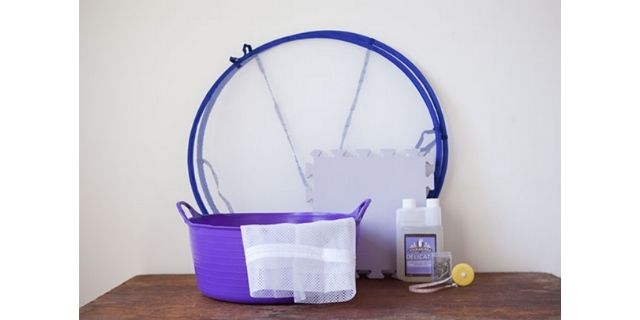
Caring for Finished Projects
Caring for superwash wool projects is an important step in the process of taking care of your knitted garments. The machine washing (and drying) actually helps the garment go back to its original shape. But heat (from the dryer or hot water) can actually cause some of the coating to melt off (and eventually your superwash yarn will felt when enough of that coating is removed and the scales are exposed).
Machine washing on a gentle cycle in cold or cool water and then placing the project on a mesh sweater rack, mat, or towel to dry are the best choices to keep your superwash wool garments in their best condition. But if you find that your project needs to be put in the dryer to get it back to its natural shape, be sure to do so on a low heat setting.
Alternatively, you can block superwash wool knits. After they’ve been through the washing machine, instead of placing them in the dryer, you can let them air dry. This is a great step for those projects that don’t need the dryer to help them bounce back to their original shape.
Blocking Superwash Wool Knits
Superwash wool garments need to be machine washed and dried to maintain their shape. But sometimes you need to open up a lace pattern or make sure a project is finished to specific measurements. If that’s the case, you may need to do more than just machine wash and dry your project.
Wet-blocking superwash wool projects: After machine-washing, place the garment on a dry towel, mat, or mesh sweater dryer and place it in its final shape, stretching any lace or other openwork designs to showcase them, pinning the garment if necessary.
Buying Superwash Wool Yarns
Superwash wool is often used for sock yarn but it’s also available in other yarn weights so you’ll be able to knit all kinds of projects in superwash yarns. In this section we’ll explore a few of the many possibilities.
Superwash Wool Sock Yarn
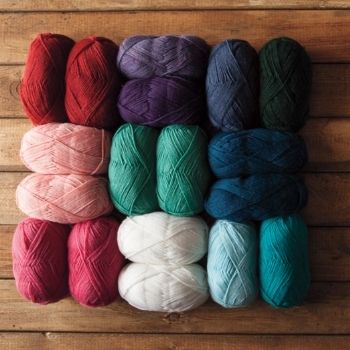
When knitters hear the words ‘superwash wool,’ they usually think of socks or fingering-weight yarn like these:
- Knit Picks Stroll
- Cascade Heritage Solids
- Debbie Bliss Rialto Luxury Sock
- Lorna’s Laces Shepherd Sock
- Dream in Color BFL Sock
Related: 12 Affordable Sock Yarns for Knitting
100% Superwash Wool Yarns
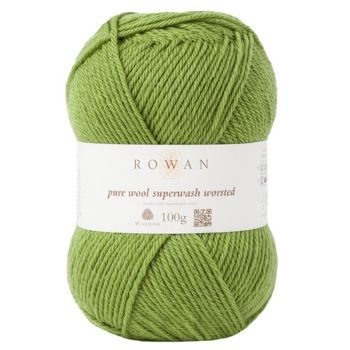
While socks are a staple in superwash wool yarns, there are plenty of other projects you can knit with superwash wool. And there are many different yarn weights for this type of yarn as well. Here are just a few 100% superwash wool yarns you can try (and most of these are available in more than one yarn weight):
- Knit Picks Swish DK
- Knit Picks Wool of the Andes Superwash Bulky
- Lion Brand LB Collection Superwash Merino
- Cascade 220 Superwash
- Rowan Pure Wool Superwash Worsted
Superwash Wool Blends

If you really want to explore the world of superwash wool – take a look at some of the yarns where superwash fibers are blended with other fibers. Here are a few examples:
- Knit Picks Mighty Stitch (acrylic & superwash wool)
- Knit Picks Capretta Superwash (Superwash Merino, cashmere & nylon)
- Spud & Chloe Sweater (superwash wool & cotton)
- Cascade Heritage Silk (Superwash Merino & silk)
- Rowan Baby Merino Silk DK (Superwash Merino & silk)
More Questions about Superwash Wool
While we’ve discussed everything you need to know to be successful with knitting with superwash wool, you may just be looking for a quick answer to your question. You’ll find some commonly asked superwash wool questions and answers right here.
What is a superwash yarn?
Superwash wool yarn has been treated to make the wool fibers machine-washable. Wool fibers are covered in scales that have a tendency to stick together (a process known as felting). To keep these fibers from felting, they are coated with a resin so the scales won’t stick together – and this means the resulting yarn that is spun from these fibers can be machine washed.
Does superwash wool stretch?
Because superwash wool fibers have scales that have been removed or coated, making them more slick and less likely to stick together, a project knit with superwash wool will stretch because those fibers can no longer stick together and help the garment keep its shape. To reduce the likelihood of your knitting project stretching, plan to knit it more firmly to help the garment hold its shape.
Can you put superwash wool in the dryer?
Superwash wool can be put in the dryer – usually on a low-heat setting. This step actually helps a garment knit in superwash wool maintain its shape. If that isn’t important, you can machine wash then place the garment on a dry towel, mat, or mesh rack to dry.
Can superwash wool be felted?
Superwash wool is smooth because the scales have been removed or coated so they cannot stick together. This means that superwash wool cannot be felted because felting occurs when the scales in wool fibers stick together when they come in contact with heat, moisture and agitation.
Is superwash wool warm?
Superwash wool is not as warm as natural wool yarns because the fibers have been coated to keep them from sticking together. Natural wool, when the fibers naturally interlock, create air pockets that trap heat and provide some natural insulation. This doesn’t happen with superwash wool because the fibers can’t stick together and create the air pockets that naturally happen with untreated wool.
Do moths eat superwash wool?
Moths will eat any natural protein fiber, even superwash wool. Be sure they are cleaned on a regular basis because moths are attracted to body oils, odours, and food stains.
We’ve discussed everything you need to know about knitting with superwash wool. If you’re looking for more information on various yarns and fibers for knitting, take a look at the resources and articles linked below.
More About Yarns & Fibers
- The Knitter’s Book of Yarn by Clara Parkes (available at Amazon)
- Yarn Substitution Made Easy by Carol J. Sulcoski (available at Amazon)
- The Fleece & Fiber Sourcebook by Carol Ekarius & Deborah Robson (available at Amazon)
